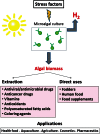Potential for green microalgae to produce hydrogen, pharmaceuticals and other high value products in a combined process
- PMID: 22765907
- PMCID: PMC3665214
- DOI: 10.3109/07388551.2012.681625
Potential for green microalgae to produce hydrogen, pharmaceuticals and other high value products in a combined process
Abstract
Green microalgae for several decades have been produced for commercial exploitation, with applications ranging from health food for human consumption, aquaculture and animal feed, to coloring agents, cosmetics and others. Several products from green algae which are used today consist of secondary metabolites that can be extracted from the algal biomass. The best known examples are the carotenoids astaxanthin and β-carotene, which are used as coloring agents and for health-promoting purposes. Many species of green algae are able to produce valuable metabolites for different uses; examples are antioxidants, several different carotenoids, polyunsaturated fatty acids, vitamins, anticancer and antiviral drugs. In many cases, these substances are secondary metabolites that are produced when the algae are exposed to stress conditions linked to nutrient deprivation, light intensity, temperature, salinity and pH. In other cases, the metabolites have been detected in algae grown under optimal conditions, and little is known about optimization of the production of each product, or the effects of stress conditions on their production. Some green algae have shown the ability to produce significant amounts of hydrogen gas during sulfur deprivation, a process which is currently studied extensively worldwide. At the moment, the majority of research in this field has focused on the model organism, Chlamydomonas reinhardtii, but other species of green algae also have this ability. Currently there is little information available regarding the possibility for producing hydrogen and other valuable metabolites in the same process. This study aims to explore which stress conditions are known to induce the production of different valuable products in comparison to stress reactions leading to hydrogen production. Wild type species of green microalgae with known ability to produce high amounts of certain valuable metabolites are listed and linked to species with ability to produce hydrogen during general anaerobic conditions, and during sulfur deprivation. Species used today for commercial purposes are also described. This information is analyzed in order to form a basis for selection of wild type species for a future multi-step process, where hydrogen production from solar energy is combined with the production of valuable metabolites and other commercial uses of the algal biomass.
Figures




References
-
- Abe K, Hattori H, Hirano M. Accumulation and antioxidant activity of secondary carotenoids in the aerial microalga Coelastrella striolata var. multistriata . Food Chem. 2007;100:656–661.
-
- Abedin RMA, Taha HM. Antibacterial and antifungal activity of cyanobacteria and green microalgae. Evaluation of medium components by Plackett-Burman design for antimicrobial activity of Spirulina platensis . Glob J Biotech Biochem. 2008;3:22–31.
-
- Ahlgren G, Gustafsson IB, Boberg M. Fatty-acid content and chemical-composition of fresh-water microalgae. J Phycol. 1992;28:37–50.
-
- Albentosa M, Pérez-Camacho A, Labarta U, Fernández-Reiriz MJ. Evaluation of freeze-dried microalgal diets for the seed culture of Ruditapes decussatus using physiological and biochemical parameters. Aquaculture. 1997;154:305–321.
Publication types
MeSH terms
Substances
LinkOut - more resources
Full Text Sources
Other Literature Sources
